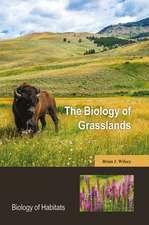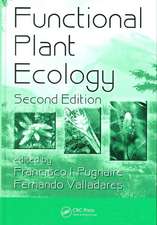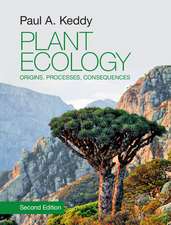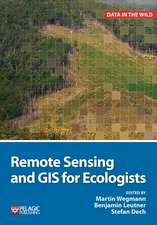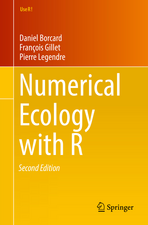Plants in Alpine Regions: Cell Physiology of Adaption and Survival Strategies
Editat de Cornelius Lützen Limba Engleză Paperback – 23 aug 2016
Tolerance against often high light intensities (including UV), cold or freezing temperatures, in addition to the need for fast tissue development, flowering, and propagation that is managed by alpine plants are to some extent underrepresented in recent research. This volume considers ice formation and winter conditions in alpine plants; the fate of cryophilic algae and microorganisms; cell structural adaptations; sexual reproduction in high altitudes; the physiology of photosynthesis, antioxidants, metabolites, carbon and nitrogen; and the influences of microclimate (temperatures at the plant level, heat tolerance), UV light, weather and ozone. Further information on life processes in alpine extreme environments may additionally yield new insights into the range of adaptation processes in lowland plants.
Preț: 1035.86 lei
Preț vechi: 1362.96 lei
-24% Nou
198.24€ • 206.20$ • 163.66£
Carte tipărită la comandă
Livrare economică 10-16 aprilie
Specificații
ISBN-10: 3709119227
Pagini: 202
Ilustrații: XII, 202 p.
Dimensiuni: 193 x 260 mm
Ediția:Softcover reprint of the original 1st ed. 2012
Editura: SPRINGER VIENNA
Colecția Springer
Locul publicării:Vienna, Austria
Cuprins
- 1. Physiological and ultrastructural changes in alpine plants exposed to high UV and to high ozon
2. Leaf cell organelle structures as modified by growth conditions and climate in alpine and polar plants
3. Ice formation and propagation in alpine plants
4. Dynamic of tissue heat tolerance and thermotolerance of PS II in alpine plants
5. Solar radiation and weather conditions of the High Alps
6. Photosynthesis and antioxidant protection in alpine herbs.
7.The accumulation of specific metabolites in plants in response to the alpine environment
8. Interaction of Carbon and Nitrogen metabolisms in alpine plants
9. From the flower to the seed: dynamics of sexual reproduction in alpine plants
10. Plant water relations in alpine winter
11. Cell structures and physiology of snow and ice algae
12. Bioclimate temperatures in mountain regions
13. Cold-adapted microorganisms in alpine soils
Notă biografică
Cornelius Lütz is Professor at the Institute of Botany at the University of Innsbruck, Austria. His research focusses on adaptation strategies and cell physiology of higher plants in alpine regions, as well as in Arctis and Antarctis.
Textul de pe ultima copertă
This book brings together experts from different fields, who used a broad spectrum of methods to investigate the physiological and cellular adaptation of alpine plants from the tree line to the upper limits. Some articles link alpine plant physiology with physiological adaptations observed in polar plants.
Tolerance against often high light intensities (including UV), cold or freezing temperatures, in addition to the need for fast tissue development, flowering, and propagation that is managed by alpine plants are to some extent underrepresented in recent research. This volume considers ice formation and winter conditions in alpine plants; the fate of cryophilic algae and microorganisms; cell structural adaptations; sexual reproduction in high altitudes; the physiology of photosynthesis, antioxidants, metabolites, carbon and nitrogen; and the influences of microclimate (temperatures at the plant level, heat tolerance), UV light, weather and ozone. Further information on life processes in alpine extreme environments may additionally yield new insights into the range of adaptation processes in lowland plants.
Caracteristici
Thematically related to plant behaviour in a changing environment,this book joins different fields of research, which results in a comprehensive view of molecular and cellular stress adaptation and stress avoidance under the aggravated conditions inhigh mountain
Descriere
High alpine plants have attracted public interest since centuries because of their often beautiful appearance, their role in traditional medicine and their obvious fitness in a harsh environment. While ecophysiology could already explain a number of survival processes in mountain plants, a survey of current research on cell physiology and ultrastructure was missing. This book brings together experts from different fields, who use a broad spectrum of methods to investigate the physiological and cellular adaptation of alpine plants from tree line to the upper limits. The combination of often high light intensities (including UV) with cold or freezing temperatures, overlaid by the demand for fast tissue development, flowering, propagation, has been managed by alpine plants, but not presented in a context of most recent research. Therefore the book considers ice formation and winter conditions in alpine plants; the fate of cryophilic algae and microorganisms; cell structural adaptations; sexual reproduction in high altitudes; physiology of photosynthesis, antioxidants, metabolites, carbon and nitrogen; influences of microclimate (temperatures at the plant level, heat tolerance), UV-light, weather and ozone.
Studying life processes in alpine extreme environments may also bring new ideas to understand the range of adaptation processes in lowland plants.


